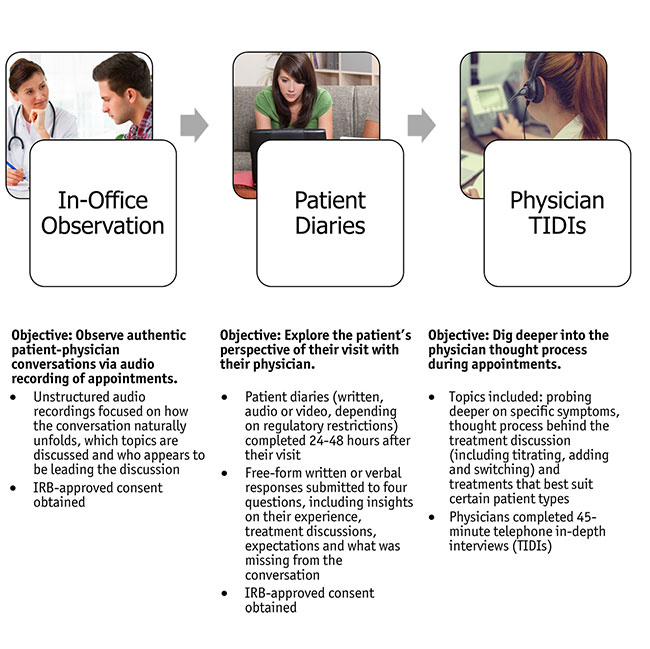Uplifting conversations
Editor's note: Lynn Clement is executive vice president at research firm KJT Group Inc. Johan Auning is senior global market research manager at pharmaceutical company H. Lundbeck A/S.
For some health care researchers, it can feel like standard qualitative interviewing techniques (even the more cutting-edge projective ones) miss the mark in uncovering the true dynamic between a doctor and her/his patient when discussing treatment options and making decisions. In-office ethnography, while considered the gold standard, has become increasingly complex and cost-prohibitive due to regulatory and privacy concerns. In addition, the speed with which health care clients need insights to inform decision-making has accelerated, placing an even greater burden on qualitative methods that weren’t designed (or intended) to quickly produce findings.
How many times have we all thought, “If only I could be a fly on the wall and have access to that dialogue!”? With a deeper understanding of this dynamic, we could be more relevant in our communications, employing language that patients both use and understand. We could ensure the right patients get access to the best diagnostic tools and treatments, improving patient outcomes and quality of life.
In this article you’ll see how pharmaceutical company H. Lundbeck A/S partnered with research firm KJT Group to uncover the nuances of the doctor/patient relationship utilizing a method developed by KJT Group several years ago. This approach simulates the in-office ethnography experience using, of all things, an age-old technology: the audio recorder!
Prior to partnering with Lundbeck, KJT launched its first study, gambling that physicians would be willing to participate and patients would consent to be part of the study. Other issues to be determined at the time: Would the audio recorder interfere with the natural cadence of the conversation? How much direction should the agency provide regarding patient selection criteria to ensure a comprehensive recording that provided insight into the dialogue? How long would it take to execute a study like this?
The idea was simple but ensuring KJT was meeting all compliance and regulatory requirements was incredibly complex. The solution included developing a study protocol and submitting for institutional review board (IRB) approval, following strict GDPR protocol and client-specific adverse-event reporting processes to gain IRB-approved consent of patients for participation. This idea, along with a willingness to take a risk in the spirit of innovation, has since morphed into a multiphase solution that KJT has executed over the past several years in the U.S., Europe and South America.
To be clear, in-office observation is not for the faint of heart, is not suitable for all disease states or treatment decisions, nor can it be executed quickly! The legal and compliance challenges are significant but manageable with the appropriate IRB-approved protocol and processes in place. Protecting patient privacy is at the heart of each engagement and is the most important component for the success of this type of project. Both physicians and patients must be confident they are being protected at every turn of this voluntary research and that their identity will not be revealed through the research process.
As it relates to the current study focused on the treatment of patients with major depression disorder (MDD), both KJT and their partners at H. Lundbeck A/S view confidentiality, compliance and data security as the project’s topmost priorities.
The goal of this type of research project is to elicit a holistic view of the patient office visit (either virtual or in-person) through the three-step approach (shown in Figure 1): in-office observation, patient diaries and physician telephone in-depth interviews.

Address challenges
When we, your co-authors, first met we talked extensively about the challenges patients face in treating their MDD, particularly the extremely confusing world of treatment options, the complex and interconnected web of depressive symptoms and patients’ engagement with their health care professionals (HCPs). Against this backdrop, H. Lundbeck A/S sought a deeper understanding of the dialogue between patients and their physicians in the examination room, how this conversation is transpiring in different countries and the patient experience of living with depression. In that initial discussion, it became clear to both parties that KJT’s in-office observation approach was well-suited to address these challenges.
While H. Lundbeck A/S has done extensive market research to support its MDD portfolio, the missing piece has been the company’s ability to investigate the disconnect between what patients and HCPs say in traditional research settings versus what actually happens. The KJT approach provided an intensive look into that interaction to ensure H. Lundbeck A/S was adequately supporting both patients and physicians to guarantee the best patient outcomes.
As both parties worked through the project plan collaboratively, several key research objectives were developed:
- Identify key discussion points in a typical appointment. What words/phrases do patients use to describe their symptoms? How does the HCP respond?
- Capture the sequence and rationale of treatment initiation, adjustment and changes to treatment.
- Identify triggers/reasons for choosing specific treatments.
- Understand the presentation to the patient of their treatment once prescribed. How is the product presented? What are the treatment goals and how do they align to overall patient functioning? How does this differ based on the symptoms the patient presents with?

In total, 120 office dialogs were recorded, alongside a robust number of diaries and follow-up interviews across North America, Latin America and Europe (see Table 1).
How is this different from existing approaches?
Custom HCP recruitment: These are not professional survey respondents nor are they pre-recruited to participate in this type of research as needed. These doctors are custom-recruited to the client’s specifications (in this case, specifications from H. Lundbeck A/S). The research team at KJT then recruits specific physician segments, physicians who prescribe particular therapies or practice in a particular setting.
Target patient visits selection criteria: Similarly, through the development of patient selection protocols that are clearly communicated to HCPs, KJT has the ability to control the type of visits that are recorded. This allows the collaborative research team to focus on data collection efforts, ensuring that targeted patient visits and relevant dialogue are gathered for analysis.
Flexibility: The ability to capture both in-person and virtual visits is critical. As the health care delivery model continues to evolve, dynamics from both remote and in-person exchanges can offer valuable insights to the client. (This particular project kicked off at the beginning of the COVID-19 pandemic, so execution of the project needed to evolve to reflect the changing care-delivery landscape.)
Global reach: Diligence must be applied to ensure compliance and adherence to privacy regulations in the U.S. and key markets of interest. KJT’s team of compliance experts helps ensure clients are protected and the appropriate protocols are followed in each country.
Holistic view of the office visit: Follow-up patient diaries and in-depth telephone interviews with participating physicians allow for the thorough exploration of patients’ perceptions of their physician interactions, physicians’ thought processes as they consult with patients and the importance of the nonverbal assessments done in the examination room.
Inform brand planning
Given the scope and criticality of this research project, H. Lundbeck A/S asked KJT to facilitate an in-person workshop to immerse its extended cross-functional team in the results of the research to inform brand planning. The workshop comprised an in-depth review of the results, including listening to selected excerpts from the office recordings, followed by a deep-dive discussion on the implications for the 2022 global brand plan.
Actions taken as a result of the meeting included:
- augmenting specific messaging and communication tactics and strategy to incorporate research findings;
- informing the continuous evaluation of the patient profile that is leveraged in HCP communications to better reflect actual language and symptom expression among patients; and
- confirming an early hypothesis regarding dosing barriers and the need to proactively address these barriers with providers.
Many additional areas of analysis were noted in the workshop and the rich data set that has been collected will continue to be leveraged to inform strategy and tactics for years to come. With its primary focus on helping patients with their brain health, this research will continue to be important in crystalizing the H. Lundbeck A/S plans for 2022 and beyond, including updated messaging that represents the company’s true understanding of how patients articulate the key symptoms of MDD.
Not a typical project
As stated earlier, this project is not a typical market research project and before you consider undertaking this engagement there are a few important things to keep in mind:
Not all therapeutic decisions are appropriate for this type of engagement. This project is best suited for a chronic condition, where the doctor has an existing relationship (and therefore trust has been established) with the patient. This aids in gaining consent and also ensuring the doctor has enough information to select the right type of visits for recording. It should not be considered for a situation where a patient is receiving a difficult diagnosis, such as cancer.
This is not a quick project to execute and should not be viewed with standard market research timelines in mind. The project highlighted in this case study took ~eight months to execute; the timeline will vary depending on the number of countries selected for inclusion. In order to do this correctly, adequate preparation and fielding time is necessary.
This cannot be executed in all countries due to feasibility and compliance concerns. We explored certain European markets (e.g., Germany, France, Russia) and were not able to complete the research due to legal requirements or willingness of patients to consent to having their interviews recorded. Cultural considerations are very important when undertaking a project of this nature.
The data provided is extensive. Homing in on key areas of interest with direction from the client team is critical to ensuring the initial analysis meets the market need. KJT tightly managed the analysis through an analytic plan co-created with H. Lundbeck A/S. The rich database can be mined for years to come.
Collaboration between the firm’s project team and the client is critical. High engagement from client partners is required to ensure success. For this particular project, an incredibly inquisitive client team at H. Lundbeck A/S remained engaged with weekly touchpoints to drive this project towards successful completion.
This is a multiphased project, with each phase building off the last to ensure learnings are optimized. The study was designed to allow for mini analyses at each research milestone. KJT and H. Lundbeck A/S were able to regroup at several different stages of the project’s lifecycle. In doing so, we could challenge each other’s hypotheses, make updates to the analytic plan and co-create the design for subsequent stages to distill the most salient data to support the overall objective of improving patient outcomes.
A privileged opportunity
Being given access to these patient/doctor dialogues is a privileged opportunity that has garnered previously unseen insight. Both KJT and H. Lundbeck A/S are thankful to all the participating physicians and patients who have granted us a front-row seat to these discussions as we seek to better understand all aspects of living with a chronic condition. The research captured the empathy displayed by these providers and the vulnerability of the patients. Both parties expressed a shared desire to find a treatment solution to return the patients to higher-functioning, better-quality lives. It has truly been an enlightening experience for all involved, from the research team to the marketing and medical affairs stakeholders. For H. Lundbeck A/S the most important outcome of this project is to utilize these insights to support health care providers in their effort to return MDD patients to optimal functioning.
